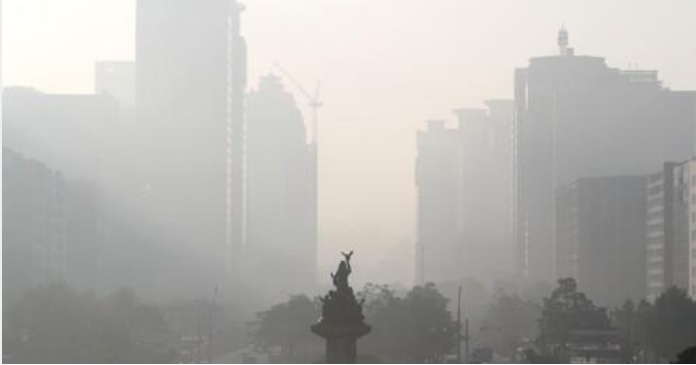South Korea will be put under the influence of harmful fine dust on Friday for the second consecutive day, due mainly to a constant influx of yellow dust particles from abroad, weather forecasters said.
The Korea Meteorological Administration and other government agencies said fine dust concentrations are expected to remain at high levels across much of the country, except parts of western and southern coastal areas.
The Korea Meteorological Administration and other government agencies said fine dust concentrations are expected to remain at high levels across much of the country, except parts of western and southern coastal areas.

Jeju's provincial government issued an advisory for PM 10, or fine dust particles smaller than 10 micrometers in diameter, at 7 a.m., with the southern resort island's PM 10 figure surging to 175 micrograms per cubic meter at that time. Jeju's air quality will stay at bad levels throughout the day before returning to normal Saturday, according to the National Institute of Environmental Research's Air Quality Forecasting Center.
In the capital areas comprising Seoul, Incheon and Gyeonggi Province, a PM 10 advisory issued Thursday night still remained in effect as of Friday morning.
In Seoul, the municipal government issued a fine dust advisory at 8 p.m. Thursday after its PM 10 reading rose to 170 micrograms per cubic meter from 158 micrograms at 7 p.m. A fine dust advisory is issued when the PM 10 figure stays above 150 micrograms for longer than two hours. The local authorities classify PM 10 levels between 81 and 150 micrograms as bad.
As of 9 a.m., PM 10 stood at 119 micrograms in Seoul, 192 micrograms in Jeju and 123 in North Jeolla Province.
Officials at KMA and the Air Quality Forecasting Center said yellow dust that originated from southern Mongolia and northeastern China between Sunday and Monday has steadily affected the air quality over the Korean Peninsula.
As fine dust particles can cause various ailments and undermine the body's immune system, government officials ask that citizens with respiratory or cardiovascular problems, children and other vulnerable people refrain from going outdoors. They also ask that citizens wear health masks when going outdoors or engaging in outdoor activities.
South Korea has been struggling to deal with fine dust particles both from home and blowing in from China, as well as yellow dust from Mongolia during the winter and spring seasons.
In Gyeonggi Province, which surrounds Seoul, 15 cities and counties, mostly in northern and eastern parts of the province, remained under a fine dust alert, as their PM 10 figures surged above 150 micrograms per cubic meter.
The KMA said fine dust will return to normal in almost all parts of the nation on Saturday, except for Gwangju, a southwestern metropolitan city, and nearby North Jeolla Province.
Meanwhile, the so-called PM 2.5 level of ultrafine dust, or the amount of particles smaller than 2.5 micrometers in diameter, remained at normal to bad levels nationwide.
As of 9 p.m., Seoul's PM 2.5 stood at 45 micrograms per cubic meter, while Busan recorded 36 micrograms. The authorities classify levels of PM 2.5 above 35 micrograms per cubic meter as "bad" and above 75 micrograms as "very bad," while the WHO recommends keeping levels below 25 micrograms. (Yonhap)




















![[Today’s K-pop] BTS pop-up event to come to Seoul](http://res.heraldm.com/phpwas/restmb_idxmake.php?idx=642&simg=/content/image/2024/04/17/20240417050734_0.jpg&u=)